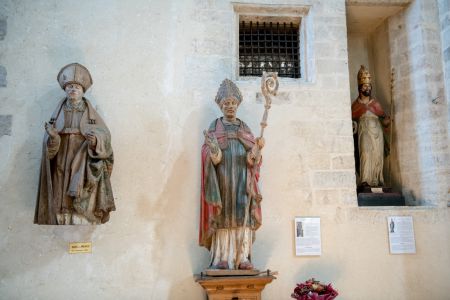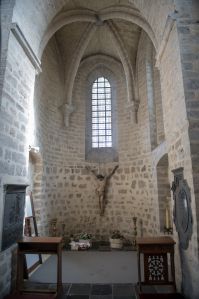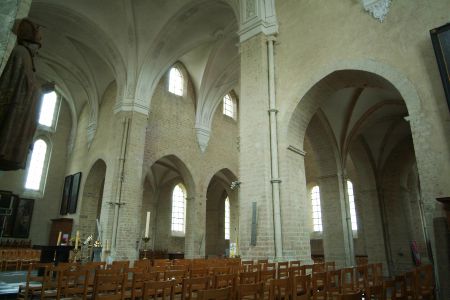Church | XIII-XIV | Romanesque | Catholic Church




Map
Opening hours
01 January - 31 December
Mon 8.30 - 17.30
Tue 8.30 - 17.30
Wed 8.30 - 17.30
Thu 8.30 - 17.30
Fri 8.30 - 17.30
Sat 8.30 - 17.30
Sun 8.30 - 17.30
Religious offices
Weekdays : 8 am
Sunday : 11 am - 6 pm
Description
The 13th century listed church of St Médard in Jodoigne is rightly recognised as one of the jewels of Brabant Wallon. This impressive building in Roman and Gothic style rediscovered its original splendour thanks to a dedicated restauration in the 1970’s.
From the entrance, the warm, white limestone of Gobertange gives the building all it lustre. From the large transept one’s gaze is drawn to the chancel in a semi circular apse and sober polychrome statues, one of which is of the patron saint, Médard. Born in 457 he was an evangelist bishop reputed as a “rain maker”. If you look closely at the statue you have the impression that he is smiling at you.
From this comes the lovely story that people still like to tell in Jodoigne. A long time ago a parishioner was reciting his prayers in the church and noticed the offering of coins that had been left in the open. Temptation was too great. The man took one, then looked at the statue of Saint Médard, who seemed to smile. So he said ”You are smiling, St Médard, OK, so I’ll take another one”, pocketing a second coin.
The surrounding area is very pleasant: a cobbled square with some trees, a clear view over part of the town, traditional houses, all of these together giving a beautiful consistency to the area. Carry on to the charming main square which is close by. Find out more about the church and view it on www.jodoigne.be/patrimoine.
Photos
Media
Remarkable elements
Choir
The vaulted, semi-circular choir is flanked by two apsidoles detached from the main apse and unobstructed during the restoration of the 1970s. These were drowned in "annexed sacristies", the removal of which made it possible to clear the small Romanesque door to the left of the choir. This one facing East has five Romanesque openings in its lower part surmounted by Romanesque arches. The upper floor has five Gothic openings, vertically aligned with the Romanesque openings. These two floors are separated by a thick cordon marking the transition from Romanesque to Gothic. The Saint-Médard church is a remarkable illustration of this transition.
Apsidioles
The right-hand apsidol when facing the central apse attracts attention by the tombstone that is located there. Until the 18th century, all the priests of Saint-Médard were in fact religious "professed of the Order of Hospitallers". The title of brother was attached to their name. We can therefore see it on Brother Joannes Stassoul's epitaph. "Here lies buried Brother Jean Stassoul, priest of this church...". The last of the Hospitaller Brothers is Remacle Mohy, who died in 1621.
The 18th century ceiling and the vaults of the side naves
The vault of the main nave is dated 1759. At that time the interior aspect of the church was completely modified. We're bringing it up to 18th century standards. The vault was therefore lowered and decorated with stuccoes. It is called a rocky vault. The original vault was a ribbed vault similar to the vaults of the two side naves. Traces bear witness to this primitive aspect of the ceiling: the beginning of this vault can be seen in the west gable, the bases of the columns supporting the vault at the bottom of the pillars, the trace of these pillars and the upper parts of the transept windows hidden by the lowered vault.
The mystical ecstasy of Saint Theresa of Avila
This religious scene of the Flemish School would be attributed to Erasmus Quellin (1607-1678), while the IRPA, to whom it was entrusted for its restoration, would tend to favour an "Anonymous" author. It is an oil on canvas that may have been painted for Saint-Médard church, although the link between Sainte-Thérèse and Jodoigne is not very well established, but at the end of the 17th and beginning of the 18th centuries, the theme was in fashion. This painting is remarkable for the delicacy of its faces and the rendering of its expressions.
St. Helena receiving a cross from the Pope
This is an oil on canvas by an unknown author dating from the early 18th century. The imposing dimensions of the work were customary for paintings exhibited in churches. It represents Saint Helena, mother of Emperor Constantine the Great who discovered the true cross in the 4th century. But it could be other saints represented here: it could be Sainte-Renèlde (7th century) who brought a piece of the cross from the Holy Land. She is venerated in Mechelen, where many of Saint-Médard's paintings come from. We would also distinguish Sainte-Radegonde (6th century), the first queen of France to receive a fragment of the cross of Emperor Justin II.
Gothic door
: The original portal served as the only entrance until 1822, when a more imposing entrance was opened in the facade, next to the single tower. In 1970, during the last restoration, this door was restored to its main entrance function. Its tympanum, where a small pedestal can be seen, was once adorned with a statue of Saint Medard. It would be the one inside the church, made of polychrome wood and whose feet would have been cut off in order to adapt to the height of the Gothic tympanum. One the left side of this door, we can see the traces of a small oratory, transformed into a hermitage in 1643. It was the chapel of the "petit Saint-Médard".





























